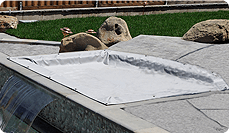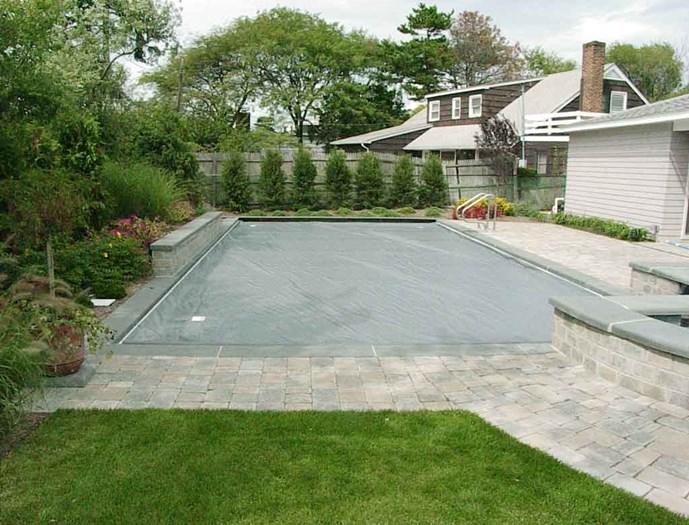
Your backyard pool is a significant investment, so it’s crucial to maintain it all year round. When summer comes to a close, you must protect your swimming pool by preparing it for winterization.
“Closing” and “winterizing” differ from each other
People sometimes confuse winterizing a pool and closing a pool. While winterizing does include closing your swimming pool, it doesn’t start there.
Closing a swimming pool is simply sealing it with a pool cover – that’s it. When your pool is closed, it’s not currently in use, but you plan to use it again soon. For instance, you may close your pool for the night and open it the next day when you’re going to use it.
Winterizing a pool, on the other hand, involves several essential steps. They include turning off the pool’s equipment, removing its accessories, and removing the water from lines and vessels. You want to take all these steps before closing the pool for the rest of the winter season.
Steps for winterizing an inground swimming pool

The purpose of winterizing a swimming pool is to protect it from the harsh effects brought by the winter season. If you don’t winterize your pool and leave it open instead during the winter, it can suffer extensive damage due to frost, such as cracks on the walls.
To prevent your inground swimming pool from the freezing weather, follow the steps below to prepare it for the coming winter months:
1) Remove pool accessories
Remove pool accessories such as ladders, steps, diving boards, and skimmer baskets from the pool. Clean the individual components, let them dry, and store them in a safe, dry place.
2) Deep-clean your pool
Make sure your swimming pool is as clean as possible by removing all leaves, branches, and other debris. Clean pool water makes it easier to balance its chemistry and prevents mold and algae growth.
Use a skim net to clean any floating debris from the water’s surface and a pool vacuum to suck in all debris from the bottom. Next, brush the pool’s floor and sides.
3) Adjust your pool water’s chemistry
Balance your pool water properly, preferably a week before closing the pool.
First, test your pool water’s chemistry to hit its desired balance (in proper order):
- Alkalinity should stay between 80 and 150 ppm (parts per million)
- pH level should be between 7.2 and 7.6
- Calcium hardness should be between 175 to 225 ppm
- The chlorine level should stay 1 to 3 ppm
Adjust the water’s chemistry as necessary, balancing its alkalinity before working on the pH level.
4) Lower your pool’s water level
If you don’t have or use a skimmer cover and you live in a region where the water usually freezes during the winter, you must lower your pool’s water level before closing.
The water level should be half a foot below the skimmer if you use a solid pool cover or a foot below the skimmer if you use a mesh pool cover.
5) Drain and store your pool equipment
Remember to drain your pool equipment. Not doing so can cause the water to expand and cause damage when temperatures become freezing.
Use a blower to drain the water from the pool lines. After clearing the pool lines, plug them up with expansion plugs. Apply pool antifreeze to prevent the pipes from bursting.
Drain every pump, filter, and heater. Also, remove all filters and clean them. It’s best to store the filter and pump indoors for the winter.
6) Add shock treatment to your pool
Before covering your pool, add shock treatment (chlorinated or non-chlorinated) to the water. Shocking the pool water will kill any harmful bacteria, algae, or combined chlorine that could damage your swimming pool.
When adding shock treatment, make sure to follow the label directions. Instead of pouring the chemicals in only one area, it’s better to distribute them evenly around the pool.
7) Cover your swimming pool
Finally, it’s time to cover your swimming pool! Pool owners choose a winter cover or a safety cover.
- Winter cover – It is a large tarp laid on top of your pool during winter to protect it from debris and sunlight. It is quick and easy to install but offers less protection compared with a safety pool cover.
- Safety pool cover – It offers much better protection than a winter cover. Plus, you can use it any time of the year, not only during the winter season. Safety pool covers are anchored down around the perimeter of your pool to provide the best possible protection against debris, sunlight, and freezing temperatures, as well as create an effective barrier against children and pets accidentally falling in.
A quality safety pool cover is a must for every pool owner
Investing in a quality safety pool cover will save you time and money, allowing you to enjoy your pool for years to come.
Here are some reasons to invest in a good-quality safety pool cover:
- Safety pool covers protect your pool by preserving its condition, making it easier to open it again for use in the springtime.
- They conserve water and energy, resulting in significant utility savings.
- They reduce the need to add chemicals to the pool water.
- They keep children and animals safe from drowning accidents.
- They make it easier to open the pool as they keep off debris and other objects from falling into the pool.
- Using safety pool covers means long-term savings and quickly returning your initial investment.
- Safety pool covers look aesthetically pleasing while protecting your pool. This is not the case with regular winter covers.
- You can use a safety pool cover any time of the year, not just during the winter season.
Safety pool covers are available in many types and colors to suit pools of different sizes and shapes, considering the extra features your pool might have, such as a fountain or waterfall. Most safety covers are made of vinyl, plastic, or mesh fabric.
Always choose a quality safety pool cover that your budget can afford. Also, a manual or motorized safety pool cover can be installed based on your pool size and budget. Motorized safety covers are convenient to operate more quickly than a manual snap-down covers.









